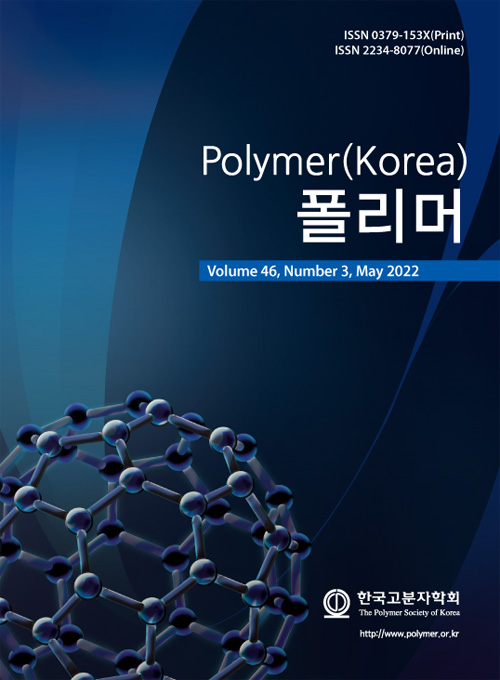- Bio-based Copolyester Fibers: Polymerization and Melt Spinning of Poly(ethylene 2,5-furandicarboxylate-co-propylene 2,5-furandicarboxylate)
Material & Component Convergence R&D Department, Korea Institute of Industrial Technology (KITECH), 143, Hanggaul-ro, Sangnok-gu, Ansan-si, Gyeonggi-do 15588, Korea
*ESC Coprosperity Division, Korea High Tech Textile Research Institute, 170, Geomjun-gil, Nam-myeon, Yangju-si, Gyeonggi-do 11410, Korea- 바이오 기반 Copolyester 섬유: Poly(ethylene 2,5-furandicarboxylate-co-propylene 2,5-furandicarboxylate)의 중합 및 용융방사
한국생산기술연구원 소재부품융합연구부문, *한국섬유소재연구원 ESC상생본부
Reproduction, stored in a retrieval system, or transmitted in any form of any part of this publication is permitted only by written permission from the Polymer Society of Korea.
Bio-based polymers including poly(ethylene 2,5-furandicarboxylate) (PEF), poly(propylene 2,5-furandicarboxylate) (PPF) and Poly(ethylene 2,5-furandicarboxylate-co-propylene 2,5-furandicarboxylate) (PEPF) were synthesized by reacting 2,5-furandicarboxylic acid (FDCA) with ethylene glycol (EG) and 1,3-propanediol (PDO). Chemical structures of synthesized polymers were characterized by FTIR and 1H NMR. In addition, the fraction of EG and PDO in copolymers were calculated from 1H NMR spectra. As the results, the fraction of PDO in copolymers was higher than EG compared to feeding ratio in synthesis. It is attributed to higher reactivity of PDO than EG. Synthesized polymers were melt-spun under different conditions according to the results of differential scanning calorimetry (DSC) and thermogravimetric analysis (TGA). And the tensile properties of the fibers were evaluated. Tensile behavior of copolyester fibers exhibited similar behavior of undrawn fibers. Thus the feasibility of bio-based copolyester fibers were confirmed.
바이오 기반 고분자인 poly(ethylene 2,5-furandicarboxylate)(PEF), poly(propylene 2,5-furandicarboxylate) (PPF), poly(ethylene 2,5-furandicarboxylate-co-propylene 2,5-furandicarboxylate)(PEPF)를 2,5-furandicarboxylic acid(FDCA)와 ethylene glycol(EG) 및 1,3-propanediol(PDO)을 이용하여 합성하였다. 합성된 고분자의 화학적 구조를 FTIR과 1H NMR로 분석하였다. 또한 1H NMR 스펙트럼을 이용하여 합성된 공중합체의 EG와 PDO 분율을 계산하였으며, 그 결과 합성 시 투입 비율 대비 공중합체의 PDO 분율이 EG보다 높았다. 이를 통해 FDCA에 대한 반응성이 PDO가 EG보다 크다는 것을 알 수 있었다. Differential scanning calorimetry(DSC)와 thermogravimetric analysis(TGA) 분석결과에 따라 합성한 고분자를 용융방사하고, 인장특성을 확인하였다. Copolyester 섬유의 인장거동은 전형적인 미연신사 거동을 보였다. 본 연구에서 바이오 기반 copolyester를 섬유로 사용할 수 있는 가능성을 확인하였다.
Keywords: bio-based polymers, poly(ethylene 2,5-furandicarboxylate), poly(propylene 2,5-furandicarboxylate), poly(ethylene 2,5-furandicarboxylate-co-propylene 2,5-furandicarboxylate, copolyesters.
- Polymer(Korea) 폴리머
- Frequency : Bimonthly(odd)
ISSN 0379-153X(Print)
ISSN 2234-8077(Online)
Abbr. Polym. Korea - 2023 Impact Factor : 0.4
- Indexed in SCIE
 This Article
This Article
-
2022; 46(3): 382-388
Published online May 25, 2022
- 10.7317/pk.2022.46.3.382
- Received on Feb 4, 2022
- Revised on Mar 24, 2022
- Accepted on Mar 31, 2022
 Correspondence to
Correspondence to
- Ki-Young Kim
-
Material & Component Convergence R&D Department, Korea Institute of Industrial Technology (KITECH), 143, Hanggaul-ro, Sangnok-gu, Ansan-si, Gyeonggi-do 15588, Korea
- E-mail: kkim@kitech.re.kr










 Copyright(c) The Polymer Society of Korea. All right reserved.
Copyright(c) The Polymer Society of Korea. All right reserved.